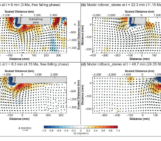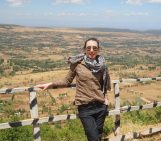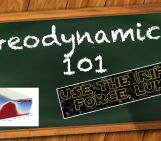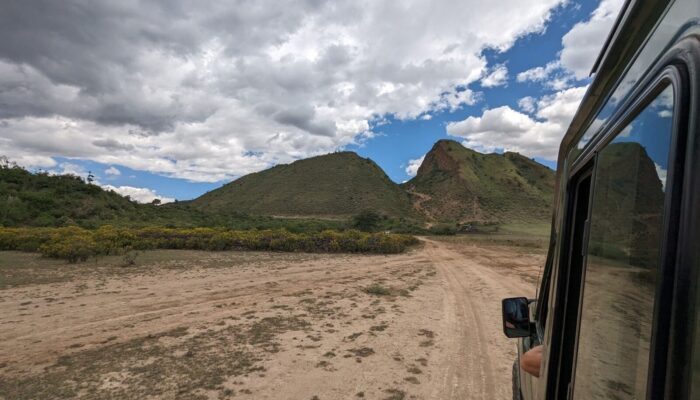
Continental rifts are a prime example of how the forces at work beneath our feet are constantly shaping our world, and often host volcanic activity. The patterns and distribution of volcanism in rift settings, however, is far from intuitive. The picture gets even more complicated if we look between the segments that often make up a rift. This week, Valentina Armeni from the University of Potsdam, Germany will show us how combining analysis of rift morphology with analogue models can help us understand why volcanoes in rift systems pop up where they do.
On the predictability of volcanism in rift settings
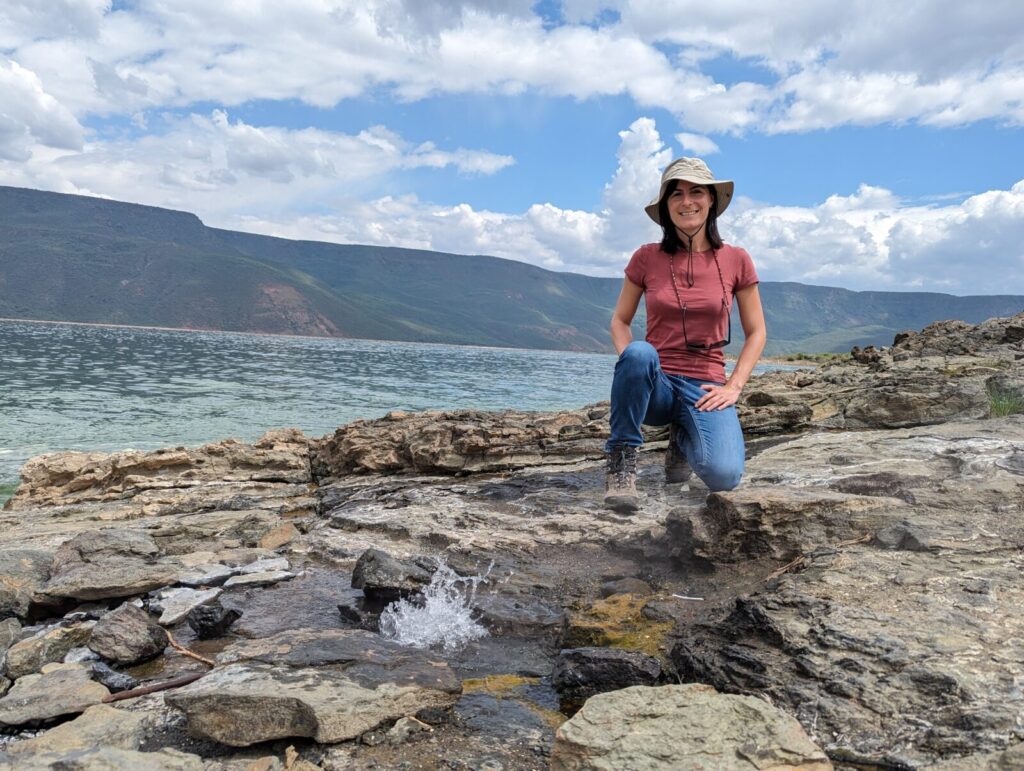
Valentina Armeni is a PhD student at the University of Potsdam, working on the interplay between surface processes and magma propagation. Her research spans volcano-tectonic, morphotectonic, dyke propagation, and analogue modelling. For her PhD project, she is studying volcanism in diverse settings, including continental rifts (East African Rift System) and subduction zones (Chile). Her approach combines field geology with high-resolution topographic analysis to better constrain analogue and numerical models of magma pathways.
Volcanism in continental rifts may look like a straightforward story: magma rises where the Earth’s crust is pulling apart. It almost feels like we should be able to predict exactly where volcanic activity will happen based on the patterns of crustal stretching. In fact, the distribution of faults and volcanic activity in rifts seems to follow predictable patterns. Volcanism usually develops either along the rift axis (hereafter, along-rift, Figure 1), during the early and late stages of extension (Ebinger & Casey, 2001; Keir et al., 2015), or on the rift flanks (hereafter, off-axis volcanism, Figure 1), during intermediate stages (Bosworth, 1987; Maccaferri et al 2014; Corti et al., 2025) .
But rift systems are rarely simple. They are made of segments, grabens or half-grabens, that may be laterally offset (Figure 1). The so-called transfer zones are complex regions that accommodate extension between rift segments (e.g., Muirhead et al., 2015). These areas may host large polygenic stratovolcanoes like Nyiragongo and Nyamuragira (East African Rift), monogenetic fields such as the Eifel volcanic field (Germany), and calderas like Okataina (New Zeland).
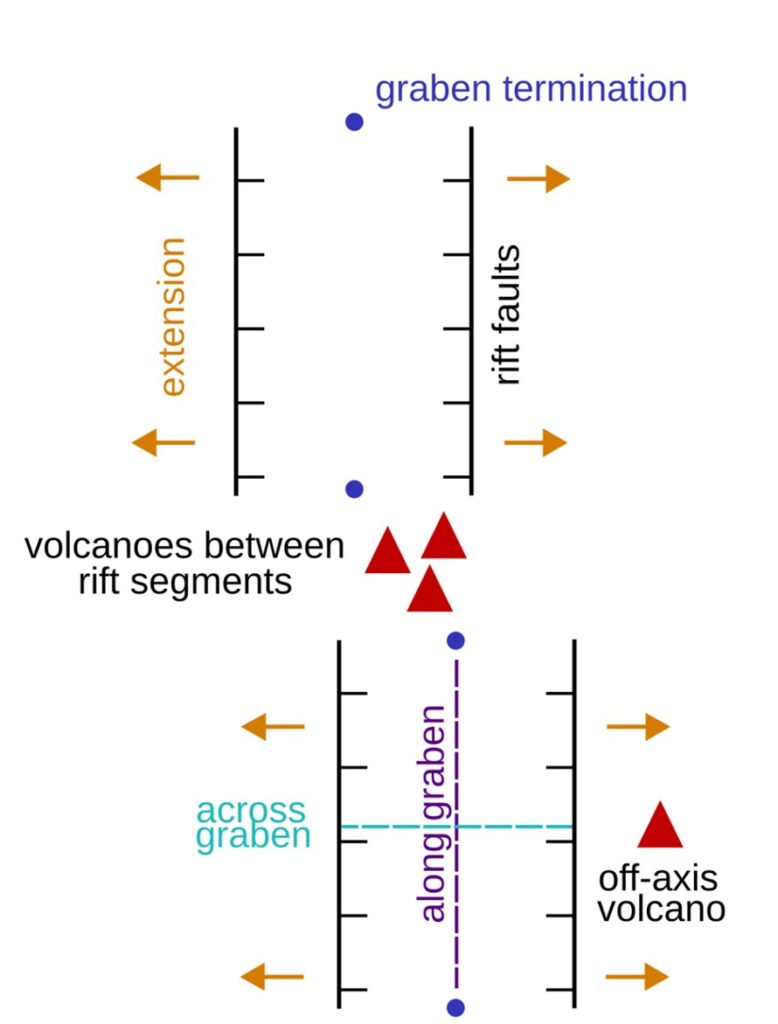
Figure 1: Schematic model of volcanic distribution in rift settings and typical graben characteristics. The diagram illustrates where volcanoes (red triangles) tend to form during continental rifting, along the rift axis and between rift segments, or on the flanks (off-axis).
For a long time, tectonic stress has been seen as the main driver controlling rift-related volcanism (e.g., Ebinger et al., 1989). However, in the last decades, a new mechanism has been “thrown into the pot” to explain the presence of off-axis volcanoes: crustal unloading caused by graben formation (e.g., Maccaferri et al., 2014; Ferrante et al., 2024). To put it briefly, the volume of a graben translates into a volume of missing rocks and, thus, missing weight (“unloading”) on the underlying crust, altering the stress field and potentially changing the game. So that’s where I started asking: what about volcanism between adjacent rift segments? Is tectonics doing all the work, or is there more coming into play?
Which rift zones to choose?
Globally, there are about a dozen active continental rift systems, such as the Baikal Rift Zone, (Russia); the Rio Grande Rift, (New Mexico); the Basin and Range Province, (USA). The list could be endless. To span a wide range of rifting conditions, we selected three rift zones (Figure 2) differing by two orders of magnitude in seismic and geodetic extension rates and an order of magnitude in crustal unloading: the Lower Rhine Graben in Germany (0.07 mm/yr; Camelbeeck et al., 2020; Figure 2c), the Virunga Volcanic Province in the Western Branch of the East African Rift System (~2 mm/yr; Saria et al., 2014; Figure 2d), and the Adda’do Magmatic Segment, in Afar (5 mm/yr; Saria et al., 2014; Figure 2e).
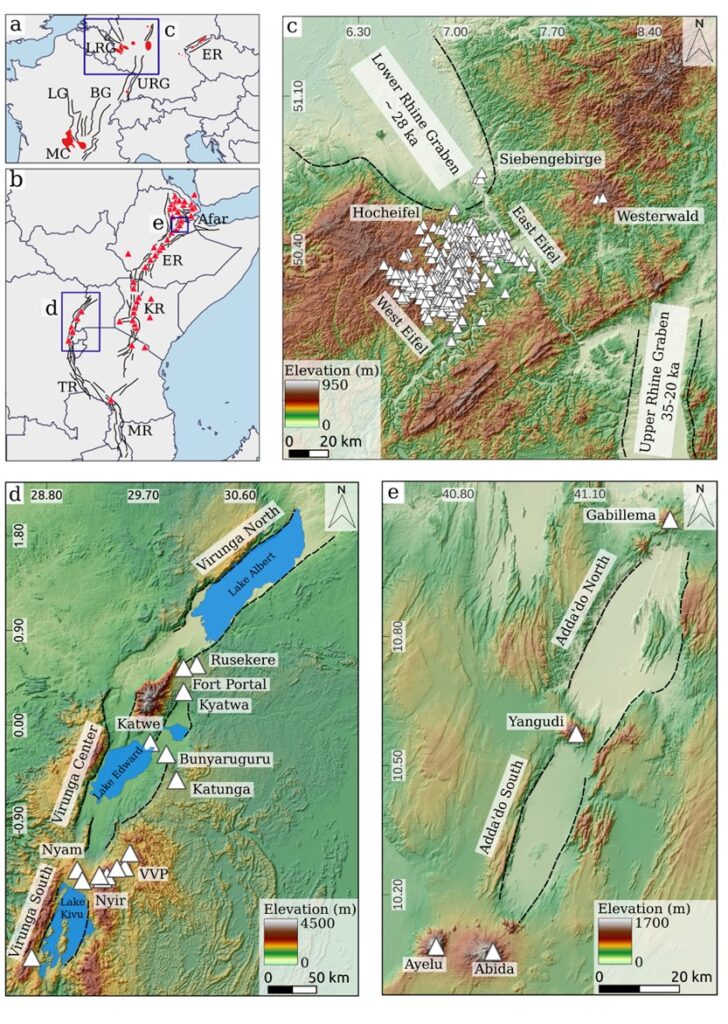
Figure 2: a) The European Cenozoic Rift System, including key features like the Massif Central (MC), Limagne Graben (LG), Bresse Graben (BG), Lower Rhine Graben (LRG), Upper Rhine Graben (URG), and Eger Graben (EG). b) The East African Rift System (EARS) with its main branches: Ethiopian Rift (ER), Kenya Rift (KR), Tanganyika Rift (TR), and Malawi Rift (MR). White triangles mark volcanic centers. The blue rectangles highlight the specific areas selected for this study. Volcanic vent locations are from the Smithsonian Global Volcanism Program (2024), with additional data for the Rhenish Massif added manually. Black dashed lines outline the rift borders. c–e) volcano-tectonic maps of the Rhenish Massif, the Western Branch of the East African Rift, and the Adda’do Magmatic Segment.
A double approach to understand magma pathways
Given the complexity of the topic, we adopted a double approach, starting with “what the landscape has become” and ending with “how it may have gotten there”.
The first step was analysing the Digital Elevation Models (DEM) to quantify graben depth, geometry, and the volume of missing material, all of which serve as proxies for the amount of crustal unloading. However, one of the challenges of working with DEM is that they offer only a snapshot of present-day topography. Besides, DEM-derived topography gives us just the surface imprint of deep processes we cannot directly observe. So, how can we see what’s going on beneath our feet?…
…This is where analogue modelling becomes invaluable! The second step involved performing a series of designed analogue experiments tracking the propagation of air-filled cracks into gelatine. These experiments were set up to simulate hydrostatic, tensional, and unloading stress conditions, allowing us to directly observe how the analogue of dykes chose their paths and where they surfaced.
What did we learn?
Our double approach, combining natural observation with controlled analogue experiments, revealed a consistent pattern: the geometry of rift segments and the amount of crustal unloading strongly influence where volcanoes form. When the grabens are shallow, volcanic centres tend to cluster near the terminations of rift segments (e.g., volcanism in the Rhenish Massif). As the graben deepens, volcanism shifts away from the rift axis deflecting toward the flanks opposite to the deepest part of the basin (e.g., volcanism in the Virunga and Toro-Ankole volcanic provinces). In the more extreme cases, volcanic activity may even be suppressed (volcanic activity, not magmatic activity!).
Analog experiments confirmed these trends. The analogue of the dyke trajectories preferred to propagate toward the terminations of the experimental rift models, just as observed between natural rift segments (e.g., Adda’do Magmatic Segment). These dykes also tended to be deflected sideways toward the rift flanks when the “graben” was deeper, mimicking the pattern observed in nature. Even without applying tensile stresses, the simulated magma pathways showed oblique orientations at surface, indicating that unloading does matter in rotating the local stress fields and therefore guiding magma. These observations suggest that the morphology of the rift itself, and not just the tectonic component, may play a fundamental role in controlling where and how volcanoes form over time.
Most importantly, our experiments revealed something “unexpected”: beyond the well-known cases where dykes propagate across or away from the rift axis, magma may also travel horizontally along the rift axis itself. This lateral propagation suggests that stress changes from graben formation can steer magma parallel to the rift, potentially resulting in eruptive centres located between adjacent rift segments.
Conclusion
The way stress is distributed and magma propagates during rifting is not random, it evolves as the rift matures. The evolution of rift segments and the deepening of grabens don’t just passively record extension, as they actively reshape the local stress field, influencing where magma is likely to erupt. This creates a cascade effect, where tectonic processes “set the stage” for magmatic ones, and the interplay between them controls the spatial and temporal patterns of volcanism.
Recognizing this “interplay” (or double contribution) is crucial, not only for understanding rift evolution but also for improving forecasts of volcanic activity in active rifts.
A personal note: finding the right words
Here is something I would like to share with the scientific community as a Ph.D. student writing her first research paper (currently under review in EPSL, so stay tuned!). Taking these first steps into academic life has been exciting, but also challenging. One of the biggest challenges I faced during this research was finding the right terminology. When working across different disciplines (e.g., tectonics, geomorphology, volcanology, geophysics, etc..), every comes with its own background, its own way of naming and describing things. Writing this paper meant constantly trying to find words that would make sense to researchers from all these different areas. It wasn’t always easy, sometimes it felt frustrating, but definitely worth it!
Even though multidisciplinarity is becoming more common in geosciences, I feel we still have a lot of work to do to really “speak the same language.” But this challenge ended up being a huge learning experience for me. It pushed me to dig deeper, to understand not just my own field but the wider scientific context. It felt a bit like being a philosopher, which is in a way, a big part of what a PhD is about, right?!
Most of all, I am grateful. This journey taught me that learning how to communicate across disciplines isn’t just an academic skill, it’s a deeply human one. And I want to thank my co-authors for their patience, support, and for sharing this adventure with me.
References: [1] Bosworth, W., 1987. Off-axis volcanism in the Gregory rift, east Africa: implications for models of continental rifting. Geology 15, 397–400. Publisher: Geological Society of America. https://doi.org/10.1130/0091-7613(1987)15<397:OVITGR>2.0.CO;2 [2] Camelbeeck, T., Vanneste, K., Verbeeck, K., Garcia-Moreno, D., Van Noten, 661K., Lecocq, T., 2020. How well does known seismicity between the Lower Rhine Graben and southern North Sea reflect future earthquake activity? Historical Earthquakes, Paleoseismology, Neotectonics and Seismic Hazard: New Insights and Suggested Procedures , 53–72. [3] Corti, G., Maestrelli, D., Bonini, M., Sani, F., 2025. Off-rift volcanism during continental rifting: Observations and models with a focus on the Main Ethiopian Rift, East Africa. Journal of African Earth Sciences , 105590. Publisher: Elsevier. https://doi.org/10.1016/j.jafrearsci.2025.105590 [4] Ebinger, C.J., Deino, A.L., Drake, R.E., Tesha, A.L., 1989. Chronology of volcanism and rift basin propagation: Rungwe Volcanic Province, East Africa. Journal of Geophysical Research: Solid Earth 94, 15785–15803. https://doi.org/10.1029/JB094iB11p15785 [5] Ebinger, C.J., Casey, M., 2001. Continental breakup in magmatic provinces: An Ethiopian example. Geology 29, 527–530. Publisher: Geological Society of America. https://doi.org/10.1130/0091-7613(2001)029<0527:CBIMPA>2.0.CO;2 [6] Ferrante, G., Rivalta, E., Maccaferri, F., 2024. Spatio–temporal evolution of rift volcanism controlled top–down by a deepening graben. Earth and Planetary Science Letters 629, 118593. Publisher: Elsevier. https://doi.org/10.1016/j.epsl.2024.118593 [7] Global Volcanism Program, Smithsonian Institution, Venzke, E., 2024. Volcanoes of the world, (v. 4.3.4). https://volcano.si.edu/gvp_votw.cfm [8] Keir, D., Bastow, I.D., Corti, G., Mazzarini, F., Rooney, T.O., 2015. The origin of along-rift variations in faulting and magmatism in the Ethiopian Rift. Tectonics 34, 464–477. https://doi.org/10.1002/2014TC003698 [9] Maccaferri, F., Rivalta, E., Keir, D., Acocella, V., 2014. Off-rift volcanism in rift zones determined by crustal unloading. Nature Geoscience 7, 297–300. Publisher: Nature Publishing Group UK London. https://doi.org/10.1038/NGEO2110 [10] Muirhead, J.D., Kattenhorn, S.A., Le Corvec, N., 2015. Varying styles of magmatic strain accommodation across the East African Rift. Geochemistry, Geophysics, Geosystems 16, 2775–2795. Publisher: Nature Publishing Group UK London. https://doi.org/10.1002/2015GC005918 [11] Saria, E., Calais, E., Stamps, D.S., Delvaux, D., Hartnady, C.J.H., 2014. Present-day kinematics of the East African Rift. Journal of Geophysical Research: Solid Earth 119, 3584–3600. https://doi.org/10.1002/2013JB010901


